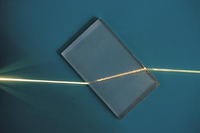
Photo from wikipedia
This article presents an ultrasound-assisted dispersive magnetic solid-phase extraction method (USA-DMSPE) to preconcentration Cd(II) and Pb(II) simultaneously. The adsorbent (mGO-βCD) was synthesized through three steps with consumption of environmentally friendly… Click to show full abstract
This article presents an ultrasound-assisted dispersive magnetic solid-phase extraction method (USA-DMSPE) to preconcentration Cd(II) and Pb(II) simultaneously. The adsorbent (mGO-βCD) was synthesized through three steps with consumption of environmentally friendly materials at room temperature. First graphene oxide (GO) was prepared via modified Hummer’s method and then magnetized by Fe3O4 precipitation (mGO). Finally, β-cyclodextrin was covalently immobilized onto the surface of mGO. X-ray diffraction patterns established pure crystallinity of the materials. Homogenous distribution of magnetic nanoparticles onto GO sheets was confirmed by scanning electron microscopy and transmission electron microscopy. FT-IR spectra proved successful modification of mGO by β-CD. Alternating gradient force magnetometer characterized magnetic property. Brunauer–Emmett–Teller showed porous structure of mGO-βCD and having high surface area. pH (7 ± 0.2), adsorption time (2 min), adsorbent amount (20 mg), eluent kind (HNO3 (3 ml of 2.0 mol L−1)) and desorption time (one minute) were optimum conditions. Sonication disperses adsorbent in sample solution, which accelerates mass transfer, as well as decreasing adsorption time and adsorbent usage amount. Applicability of the method was investigated according to preconcentration factor (Pb(II): 200 and Cd(II): 167), linearity of dynamic range (Pb(II): (2–410) and Cd(II) (3–400 μg L−1), limit of detection (Pb(II): 0.64 and Cd (II): 0.9 μg L−1), relative standard deviation (Pb(II): 1.68% and Cd(II): 2.51%) and adsorption capacity (Pb(II): 188.68 and Cd(II): 78.12). mGO-βCD was reusable for ten times and durable in six months. Selectivity and effect of interference ions were reported. Obtained recoveries for real samples verified the satisfactory performance of the method.
Journal Title: Research on Chemical Intermediates
Year Published: 2021
Link to full text (if available)
Share on Social Media: Sign Up to like & get
recommendations!